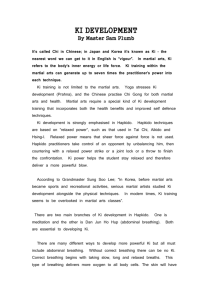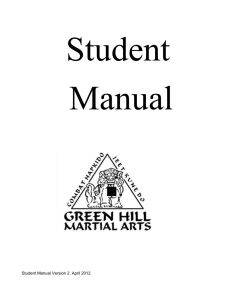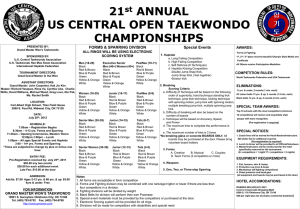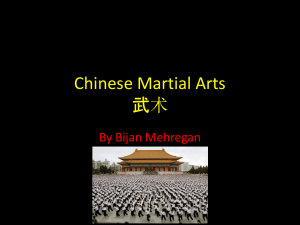My Journey with the "Three HKDs"
advertisement
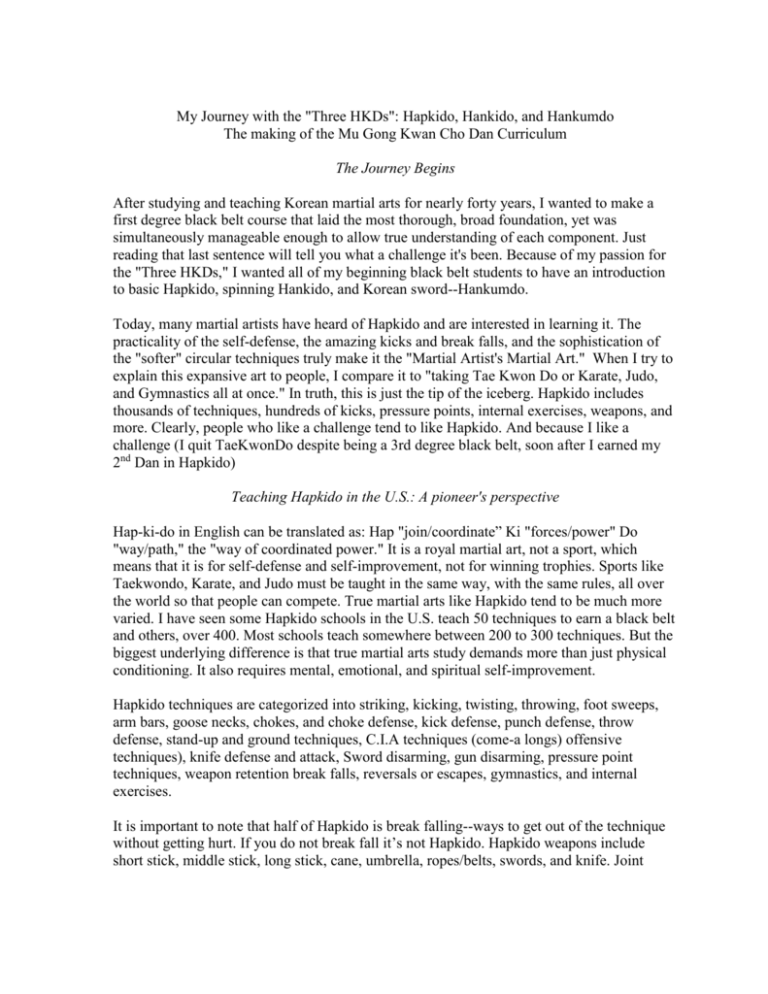
My Journey with the "Three HKDs": Hapkido, Hankido, and Hankumdo The making of the Mu Gong Kwan Cho Dan Curriculum The Journey Begins After studying and teaching Korean martial arts for nearly forty years, I wanted to make a first degree black belt course that laid the most thorough, broad foundation, yet was simultaneously manageable enough to allow true understanding of each component. Just reading that last sentence will tell you what a challenge it's been. Because of my passion for the "Three HKDs," I wanted all of my beginning black belt students to have an introduction to basic Hapkido, spinning Hankido, and Korean sword--Hankumdo. Today, many martial artists have heard of Hapkido and are interested in learning it. The practicality of the self-defense, the amazing kicks and break falls, and the sophistication of the "softer" circular techniques truly make it the "Martial Artist's Martial Art." When I try to explain this expansive art to people, I compare it to "taking Tae Kwon Do or Karate, Judo, and Gymnastics all at once." In truth, this is just the tip of the iceberg. Hapkido includes thousands of techniques, hundreds of kicks, pressure points, internal exercises, weapons, and more. Clearly, people who like a challenge tend to like Hapkido. And because I like a challenge (I quit TaeKwonDo despite being a 3rd degree black belt, soon after I earned my 2nd Dan in Hapkido) Teaching Hapkido in the U.S.: A pioneer's perspective Hap-ki-do in English can be translated as: Hap "join/coordinate” Ki "forces/power" Do "way/path," the "way of coordinated power." It is a royal martial art, not a sport, which means that it is for self-defense and self-improvement, not for winning trophies. Sports like Taekwondo, Karate, and Judo must be taught in the same way, with the same rules, all over the world so that people can compete. True martial arts like Hapkido tend to be much more varied. I have seen some Hapkido schools in the U.S. teach 50 techniques to earn a black belt and others, over 400. Most schools teach somewhere between 200 to 300 techniques. But the biggest underlying difference is that true martial arts study demands more than just physical conditioning. It also requires mental, emotional, and spiritual self-improvement. Hapkido techniques are categorized into striking, kicking, twisting, throwing, foot sweeps, arm bars, goose necks, chokes, and choke defense, kick defense, punch defense, throw defense, stand-up and ground techniques, C.I.A techniques (come-a longs) offensive techniques), knife defense and attack, Sword disarming, gun disarming, pressure point techniques, weapon retention break falls, reversals or escapes, gymnastics, and internal exercises. It is important to note that half of Hapkido is break falling--ways to get out of the technique without getting hurt. If you do not break fall it’s not Hapkido. Hapkido weapons include short stick, middle stick, long stick, cane, umbrella, ropes/belts, swords, and knife. Joint setting techniques, acupressure, meditation, Don Jon Ki Gong and Yun Gong round out the curriculum. Some schools teach a variety of components, but limit the number of techniques; others focus on techniques almost exclusively (no break falls, internal arts, acupressure, etc.). Very few schools attempt, much less succeed, in maintaining high standards in terms of both their breadth and depth of study of Hapkido. Adding Hankido and Hamkumdo I later expanded my martial arts journey to include two additional, complementary arts: Hankido and Hankumdo. Hankido, the "Korean way of power" is a more internal art that uses spinning techniques comparable to Aikido. It focuses on "more ways" to perform the deceptively simple-sounding curriculum of 12 offensive and 12 defensive techniques. Hankido was developed by Hapkido legend Myung Jae Nam in the 1980s. I had the rare honor to learn this art just as it was emerging, and from Master Myong himself. Hankumdo, or "Korean sword way" was also developed by Master Myong in the 1990s, and again, through the recommendations of my master and others, I was honored to be one of the first people, and one of very few Americans, to earn Master-level certification in this special art. The Mu Gong Kwan Cho Dan curriculum blends all three HKDs, making it easier for students with this black belt to continue in Hankido and Hankumdo (they don’t have to begin at white belt level). This curriculum teaches simple combat techniques, curved and straightline techniques, water theory (smooth circular movement), using the opponents force against them, leverage, and big circle and techniques were you join your force with the attacker force which is referred to as (Harmony.) Marshall Gagne is an 8th Dan in Mu Gong Kwan, the highest in the U.S; he is a 7th Dan in Hapkido, which is registered with the International HKD Federation in Korea. Our Dan certification comes from IHF. Grandmaster Gagne offers seminars for anyone that would like to learn the three HKDs. he is in Greenville SC close to the GSP airport. There are plenty of nearby hotels or you can sleep at the Do Jang.
